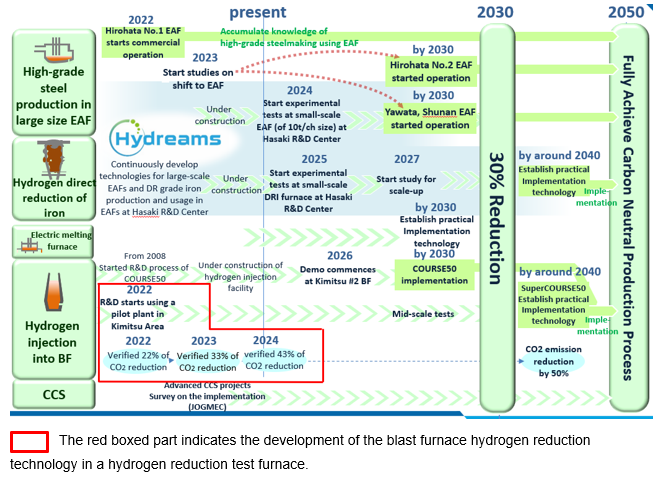

Dec. 20, 2024
Nippon Steel Corporation
Nippon Steel Corporation (hereafter "Nippon Steel") has been undertaking the
development of three super-innovative technologies under the "Nippon Steel Carbon Neutral Vision
2050," with support from the Japanese government*. One of these technologies is hydrogen injection
into blast furnaces, which uses hydrogen instead of coal to reduce iron ore in a blast furnace, thereby
significantly reducing CO2 emissions. Now, Nippon Steel has achieved the world’s first
CO2 emission reduction of over 40% (actual result of 43%) in a test furnace, reaching the
development goal in the test furnace ahead of schedule.
Currently, there are approximately 800 blast furnaces (including 20 in Japan) around the world, mainly in
East Asia. Blast furnace manufacturers around the world, including those in China, which accounts for
about half of the world's crude steel production, are striving to develop blast furnace decarbonization
technologies. Among these, the 43% CO2 emission reduction achieved by the test furnace greatly
exceeds the results disclosed in Japan and overseas. This indicates that Nippon Steel is a world leader in
the development of decarbonization technologies.
With regard to the development of blast furnace hydrogen reduction technology, Nippon Steel has been
conducting development tests of its Super COURSE50 technology, a technology that uses heated hydrogen to
reduce CO2 emissions, in the test furnace (inner volume 12 m3) at the East Nippon Works Kimitsu
Area since May 2022. So far, Nippon Steel has made steady progress in its development of this technology
in terms of verifying the world’s highest levels of a 22% reduction in CO2 emissions from
the blast furnace in 2022 followed by 33% in 2023. In the test conducted from November to December 2024,
Nippon Steel verified a 43% reduction in CO2 emissions, renewing the world’s highest
level.
In the current blast furnace steelmaking process, iron ore, which is iron oxide, is reduced and melted
using coal (carbon). While reduction by coal (carbon) is an exothermic reaction, reduction by hydrogen is
an endothermic reaction, which poses technical challenges in that it is difficult for the reduction
reaction to proceed and for the iron ore to melt. In this test, a CO2 emission reduction of 43%
was achieved by improving the heat balance inside the blast furnace during the use of heated hydrogen when
increasing the reduction with hydrogen instead of carbon.
Based on the establishment of the hydrogen reduction technology in the test furnace, Nippon Steel will
continue to develop technologies that reduce CO2 emissions from the steelmaking process by more
than 50%, including the development of scale-up technology, and accelerate efforts aimed at practical use
in large blast furnaces.
* This development project was selected as one of the Green Innovation Fund projects under the New Energy
and Industrial Technology Development Organization (NEDO) in January 2022, and funding was expanded in
November 2023. The project is being developed by a consortium of four companies: Nippon Steel Corporation,
JFE Steel Corporation, Kobe Steel, Ltd., and the Research and Development Center for Metals.
